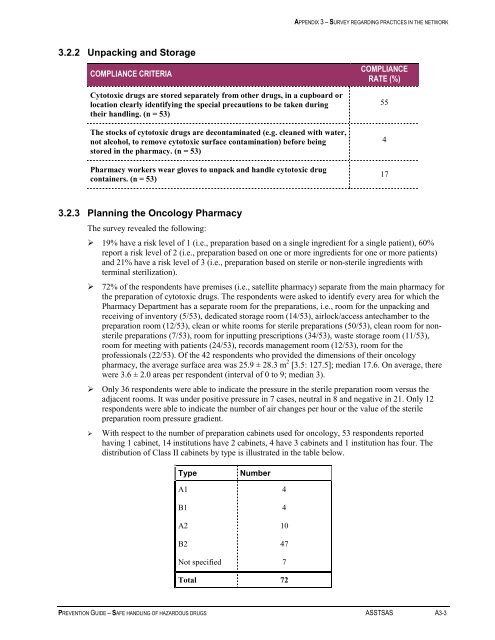Prevention Guide - Safe Handling of Hazardous Drugs - Irsst
Prevention Guide - Safe Handling of Hazardous Drugs - Irsst
Prevention Guide - Safe Handling of Hazardous Drugs - Irsst
Create successful ePaper yourself
Turn your PDF publications into a flip-book with our unique Google optimized e-Paper software.
APPENDIX 3 – SURVEY REGARDING PRACTICES IN THE NETWORK<br />
3.2.2 Unpacking and Storage<br />
COMPLIANCE CRITERIA<br />
Cytotoxic drugs are stored separately from other drugs, in a cupboard or<br />
location clearly identifying the special precautions to be taken during<br />
their handling. (n = 53)<br />
The stocks <strong>of</strong> cytotoxic drugs are decontaminated (e.g. cleaned with water,<br />
not alcohol, to remove cytotoxic surface contamination) before being<br />
stored in the pharmacy. (n = 53)<br />
Pharmacy workers wear gloves to unpack and handle cytotoxic drug<br />
containers. (n = 53)<br />
COMPLIANCE<br />
RATE (%)<br />
55<br />
4<br />
17<br />
3.2.3 Planning the Oncology Pharmacy<br />
The survey revealed the following:<br />
‣ 19% have a risk level <strong>of</strong> 1 (i.e., preparation based on a single ingredient for a single patient), 60%<br />
report a risk level <strong>of</strong> 2 (i.e., preparation based on one or more ingredients for one or more patients)<br />
and 21% have a risk level <strong>of</strong> 3 (i.e., preparation based on sterile or non-sterile ingredients with<br />
terminal sterilization).<br />
‣ 72% <strong>of</strong> the respondents have premises (i.e., satellite pharmacy) separate from the main pharmacy for<br />
the preparation <strong>of</strong> cytotoxic drugs. The respondents were asked to identify every area for which the<br />
Pharmacy Department has a separate room for the preparations, i.e., room for the unpacking and<br />
receiving <strong>of</strong> inventory (5/53), dedicated storage room (14/53), airlock/access antechamber to the<br />
preparation room (12/53), clean or white rooms for sterile preparations (50/53), clean room for nonsterile<br />
preparations (7/53), room for inputting prescriptions (34/53), waste storage room (11/53),<br />
room for meeting with patients (24/53), records management room (12/53), room for the<br />
pr<strong>of</strong>essionals (22/53). Of the 42 respondents who provided the dimensions <strong>of</strong> their oncology<br />
pharmacy, the average surface area was 25.9 ± 28.3 m 2 [3.5: 127.5]; median 17.6. On average, there<br />
were 3.6 ± 2.0 areas per respondent (interval <strong>of</strong> 0 to 9; median 3).<br />
‣ Only 36 respondents were able to indicate the pressure in the sterile preparation room versus the<br />
adjacent rooms. It was under positive pressure in 7 cases, neutral in 8 and negative in 21. Only 12<br />
respondents were able to indicate the number <strong>of</strong> air changes per hour or the value <strong>of</strong> the sterile<br />
preparation room pressure gradient.<br />
‣ With respect to the number <strong>of</strong> preparation cabinets used for oncology, 53 respondents reported<br />
having 1 cabinet, 14 institutions have 2 cabinets, 4 have 3 cabinets and 1 institution has four. The<br />
distribution <strong>of</strong> Class II cabinets by type is illustrated in the table below.<br />
Type<br />
Number<br />
A1 4<br />
B1 4<br />
A2 10<br />
B2 47<br />
Not specified 7<br />
Total 72<br />
PREVENTION GUIDE – SAFE HANDLING OF HAZARDOUS DRUGS ASSTSAS A3-3

















